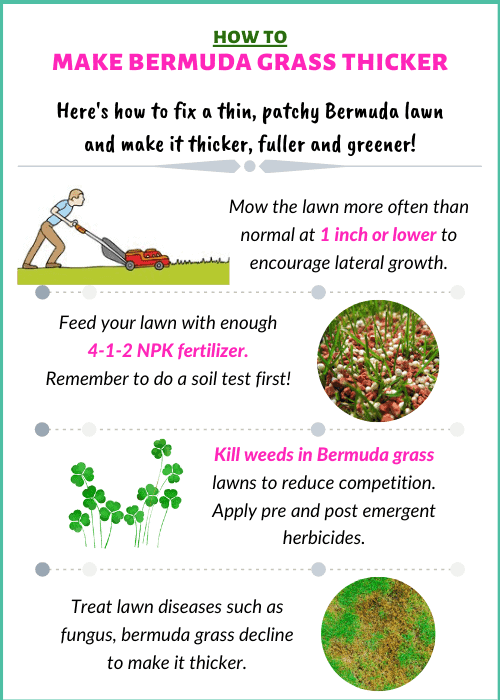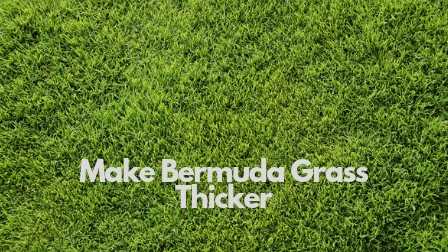Apart from its excellent drought, and salt tolerance, another trait I love about Bermudagrass is its thick growth.
However, Bermudagrass lawns may sometimes experience thinning in one or more areas. Luckily, from my experience, they are a few ways to grow a lush Bermudagrass lawn.
Quick Answer
If you’re wondering how to make Bermuda grass thicker, greener, and fuller, here are the tasks I perform to fix the sparseness:
- Mowing the lawn closer
- Applying 4-2-1 fertilizer
- Applying pre-emergent herbicide
- Applying post-emergent herbicide
- Aerating your lawn
- Treating lawn diseases
Read on for pro tips on performing these tasks properly.
6 Ways to Make Bermuda Grass Thicker
A thick, green lawn requires the right care and maintenance. If you start early enough, you’ll get this a little bit later in the year, which is usually the best time for lawns with Bermuda grass.
Following a calendar is very important because a step-by-step approach to growing and nurturing your lawn will prevent the thinning problem and promote thick lawns.

Here are 6 great ways to make your Bermuda grass lawn thicker and healthier:
1. Mow the lawn closer
Mowing is very important if you’re trying to grow a thicker lawn. What mowing does is it makes the grass grow and spread laterally wide as opposed to vertical growth.
What you want to do is mow a bit lower than you’re used to. But what is the best mowing height for Bermuda grass? Usually, we recommend you mow slightly lower than 1 inch, which means you need to use the right mower for this type of grass.
A good lawn mower for this job is one that delivers a clean cut instead of hacking the grass. Reel mowers are great at this and my favorite for Bermuda grass is the Scotts 2000-20 20-Inch lawn mower.
Also, mow a little more frequently than you’re usual to promote faster growth. But that’s not all you need to do to make Bermuda grass thicker, dense, and green.
Observe the following two tips to promote the growth of Bermuda lawns.
- Always follow the mowing with water.
- Always check and increase fertilizer levels. But it’s important to perform a soil test first.
I’ve discussed more on these two points in the sections below. It’s important to note that these tips don’t just apply to Bermuda grass.
Almost any type of grass will grow thicker if you use this technique. It just happens that Bermuda grass is very responsive to this method. That’s why you find golf courses with carpet-like grass – thick, green, and healthy. They mow almost every day!
Related: 6 Best Lawn Mowers with the Cleanest Cut for Bermuda Lawns

2. Feed your lawn with 4-1-2 fertilizer or a 16-4-8
So when to fertilize Bermuda grass?
The best times to push your lawn to grow thicker and get a beautiful lush green look are spring and early summer.
This timing is usually the best, especially for lawns with Bermuda grass. So, feed it with enough fertilizer to grow as fast as it can.
- Do a soil test to determine the low-level nutrient.
- Apply adequate general-purpose fertilizer – NPK (Nitrogen, Phosphorus, Potassium) in the ratio of 4:1:2 or a 16-4-8 is great for pushing Bermuda growth and spread.
- Phosphorus-free fertilizer blend with fine particle size that includes humic acid, which helps increase turf quality and reduce nutrient requirements
- Contains MUtech coated slow release nitrogen to provide uniform growth and extended feeding
- DG particles do not rely on a physical coating to release nutrients. Coated fertilizers (used by our competitors) are very susceptible to damage from mowers, resulting in premature nutrient release.
Affiliate links and images pulled from the Amazon Product Advertising API on: 2025-07-04
Healthy plants require fertilizer with the three elements in the ratio of 4:1:2. So, before you start applying anything on your lawn, start by testing the soil. If low fertilizer levels are causing your lawn to appear thin, then you know it is time to apply fertilizer.
The benefit of applying adequate fertilizer is that it stops disease, and weeds, and makes your lawn more drought-resistant.
Most lawns with Bermuda grass start to thin out when there’s a drought. You can prevent this by ensuring your lawn grows as dense as possible prior to that season.
Also, consider a lawn care subscription box called Sunday.
3. Apply pre-emergent weed herbicide
Lawns that have weeds often show signs of thinning and patchiness. If this symptom recurs every year, what you need to do is control weeds.
Preventing weeds such as poa annua, crabgrass, and quackgrass from growing is one of the best ways to make your Bermuda grass lawn thicker, greener, and fuller.
- Apply pre-emergent early enough in the spring to prevent most weeds from germinating and choking out your bermudagrass.
- If you think there’s a heavy weed infestation, a great yard care tip is to apply pre-emergent every 60 to 90 days.
I wrote a very detailed article on the best pre-emergent and post-emergent herbicides here. Check it out if you are at this stage. Also, here is my guide on how to differentiate Bermuda grass from crabgrass.
If you stop the weeds early enough, you’ll not have to worry about those hot months such as June, July, and August.
Applying lawn weed killers during these months usually has a negative impact on the growth and development of your lawn. Avoid spraying weed killers over 90-degree heat.
From experience, the worst weeds that thin out Bermuda lawns are quackgrass and crabgrass (click the link to see their comparison).
When these two grass weeds take over, they limit the growth of other lawn grasses because they’re dominant and aggressive. Aggressive lawn weed control measures are the best ways to get a thicker lawn easily.
4. Apply post-emergent on visible weeds
Now, there are times when you’ll already have weeds growing in your yard. In this case, you’ll need a post-emergent herbicide to get rid of crabgrass and other broad-leaf grassy weeds.
There are different ways of getting rid of such weeds, including uprooting, killing them with a post-emergent herbicide, etc. Here’s a list of application methods.
My favorite method is using a herbicide. You don’t want to apply it all over your lawn. Try to focus on the affected areas to kill the weeds in those spots and allow Bermuda grass to grow out thick and full.
- 6 MONTH WEED CONTROL: Kills existing lawn weeds and prevents listed weeds from emerging, enjoy up to 6 months of protection with our 2-in-1 formula
- HELPFUL WEED KILLER: Kill over 200 listed weeds including dandelions and clover with our lawn weed killer
- RAPID RAINPROOF FORMULA: Rainproof protection in one hour after application
Affiliate links and images pulled from the Amazon Product Advertising API on: 2025-07-04
Note that weeds such as quackgrass are very difficult to control because they grow and spread their root system underground. You might need a serious plan to be able to get rid of them if an extensive part of your lawn is affected.
5. Aerate your lawn
So when to aerate Bermuda grass?
You’ve probably been advised to aerate your lawn in late spring and early summer. That’s correct, but for a healthy, thicker Bermuda grass lawn, aerate as soon as your grass starts to turn all green to enhance even stronger and faster growth.
Also, it is best to aerate just after scalping when the grass is still short. If you have clay soil or any hard-packed soil in your lawn, you must start aerating very early to promote better nutrient and water penetration.
6. Treat lawn diseases
As I’ve already mentioned, lawn diseases could be the reason for thin Bermuda grass. Fungal infections, for example, can affect the growth and health of bermudagrass.
Spring dead spot, brown patch disease, and dollar spot are very common fungal diseases that usually cause slow growth and thinning in the turf.
Another deadly disease that can also lead to a thin lawn is root rot, also called Bermuda decline. It affects the roots and eventually leads to poor growth and thin lawns.
Spring spot manifests as small circular patches that start to spread out and form larger areas that are affected. This problem usually starts in the fall but shows up in the spring. It is also probably a sign that you applied really large amounts of nitrogen in the lawn.
Dead root is usually a consequence of poorly aerated soil. If your lawn has clay soil, aerating it should be at the top of your agenda if you want to make it thicker, fuller, and healthier.
Grubs and Japanese Beetles are some of the lawn insects that may also affect your lawn and make it thinner than you like.
Is There Too Much Shade?
You might also want to consider how much shade is in your yard. Bermudagrass requires a lot of direct sunlight If there are too many trees, buildings, and other structures affecting the lawn, you’ll likely experience thin areas.
Consider reducing the amount of shade to allow your bermudagrass to grow thicker faster.
Why Is My Bermuda Grass Not Growing?
There are several reasons why your Bermuda grass lawn is showcasing stunted growth, starting with the application of the wrong fertilizer or the right fertilizer at the wrong time.
Bermuda grass requires the right nutrients to grow, and it’s important to perform a soil test to determine what nutrients are missing in the soil.
Once you buy the right bag of fertilizer for your Bermuda grass lawn, maintaining a fertilizer schedule is imperative for your lawn’s future health.
Another big reason why your Bermuda grass isn’t growing is because you’ve forgotten to aerate the soil. Aeration is a process that allows nutrients and water to reach the grassroots to foster better growth instead of compacted soil.
While you’re at it, make sure that you don’t have excess thatch in your lawn, which if not removed can choke out new grass growth.
When mowing Bermuda grass, cut to a height of an inch to encourage Bermuda grass to begin growing outwards.
Most importantly, Bermuda grass will have a hard time growing if your lawn is plagued with weeds, which you can get rid of by using post-emergent herbicides.
FAQs
How Often Should I Water Bermuda Grass?
A good watering schedule for Bermuda grass is once every three days during the summer but avoid watering every day. Bermuda grass goes dormant in the winter and doesn’t require watering.
How Do I Deal with Brown Patches in Bermuda Grass?
If you notice brown patches in your Bermuda grass lawn, the first thing to do is perform a soil test to ensure you’re feeding your lawn with the right nutrients.
Given that Bermuda grass is a warm-season grass, Bermuda grass does develop brown patches – something that’s normal for this type of grass.
Certain types of fungus can also cause brown patches, which can be treated with the right fungicides.
Should I Dethatch My Bermuda Grass?
You should dethatch your Bermuda grass lawn only if you have an excess layer of thatch – ½-inch and above. The best time to dethatch your Bermuda grass lawn is from early July through the end of August.
What Can I Do About Thin Bermuda Grass?
There are several ways to make Bermuda grass thicker including mowing the lawn closer, feeding your lawn with the right fertilizer, and treating lawn diseases.
Final Thoughts
Bermuda grass is a warm-seaon grass that’s hailed for its unmatched heat and drought tolerance. If your Bermuda grass is showing signs of thinning, there’s no reason to break sweat just yet but use the techniques to rejuvenate your Bermuda grass turf.
Improve Bermuda Grass Lawn Health and Thickness
References
- Texas A&M University – Cooperative Extension: Bermudagrass Decline
- University of Arkansas System: DIVISION OF AGRICULTURE, RESEARCH & EXTENSION: Bermuda Grass Lawn Care Calendar
Related Posts
How To Get Bermuda Grass To Spread Fast?
How to Paint a Lawn?
Hi, Alex Kuritz here. Growing up I remember that my family had one of the best lawns in the neighborhood. Richly green and lush. I did a lot as I grew up in terms of caring and tending for not only my family’s lawn but also my neighbors. I can say I have years of experience, and I am here to share it with you.





Did you read the Tenacity label? It says NOT to use it on Bermudagrass.
Will Scotts three in one be ok to use on. Bermuda Grass?
Hi Jim, yes I have used Scotts 3-in-1 plenty of times on my Bermuda lawn. I applied it about a month ago on my parents lawn and it looks pretty sharp right now. Before they had some basic winter weeds but those have browned up.
Hi Alex, thanks for this article. I live in Arkansas and am having trouble finding a fertilizer with in the ratio of 4:1:2. Can you tell me what to search for?
Hi Sharon, thanks for commenting. I apologize for the delay. Did you ever find a good fertilizer to use?
What should I do to my yard NOW
I have poor soil in places. I was thinking of spreading compost this winter to allow nutrient to sink into the soil over the winter in order to be ready for spring. Do you think this is a good idea or bad. I have a Bermuda lawn.
That ‘should’ be a good idea, just depends on your soil condition now. Best to do a soil test first to see what’s lacking and the put that down so when spring rolls around you’ll have the best chance for ideal growing.
I live in New Mexico down by the Texas line, we have mostly sand and Colicchie, will Bermuda grass take in this type of Terrain?
Bermuda should grow fine there but you may need to amend your soil with compost to get the right pH level between 6.0-7.5. Do a soil test first to see where you are at.